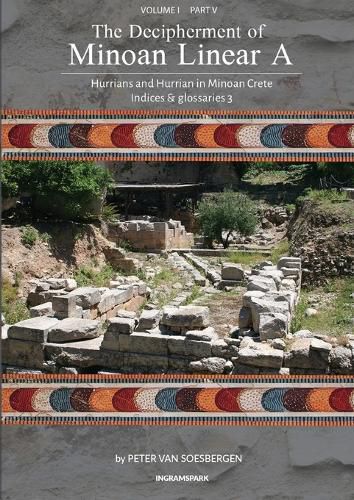Readings Newsletter
Become a Readings Member to make your shopping experience even easier.
Sign in or sign up for free!
You’re not far away from qualifying for FREE standard shipping within Australia
You’ve qualified for FREE standard shipping within Australia
The cart is loading…






This title is printed to order. This book may have been self-published. If so, we cannot guarantee the quality of the content. In the main most books will have gone through the editing process however some may not. We therefore suggest that you be aware of this before ordering this book. If in doubt check either the author or publisher’s details as we are unable to accept any returns unless they are faulty. Please contact us if you have any questions.
One feature of Minoan-Hurrian appears to corresponds specifically with the evidence from Nippur, where Hurrian personal names are attested with the theophorous element irmi / ermi as a variant of erwi at Nuzi and ewri / ibri 'Lord' and 'king' in the Tusratta letter and elsewhere, cf. Ir-me/mi-ta-at-ta and Ir-me-ta-ta at Nippur (Clay PNCP, 93), to be read Erme/i-tatta, i.e. *Erwi-tatta, according to P.M. Purves (NPN, 263). But Linear A erwi also occurs. Several personal names with the element e-mi / i-mi are attested in Linear A. They can be identified with ermi / irmi, since according to Linear A and B orthographic conventions -r- preceding -m- is not expressed in consonant clusters. Linear A wa-du-ni-mi (HT 6b.1; HT 85b.4-5) at Hagia Triada can be analysed as an Old Hurrian indicative sentence name wad=u=n-irmi or wand=u=n-irmi 'The Lord has made him/her (the child) good, just'. Linear A i-mi-sa-ra (HT 27+HT 48a.3), Hurrian *Irmi/Ermi-sarra, can be analysed as Irmi/Ermi-sarr(=i)=a, 'The Lord is like the King of Gods'. Linear A ja-re-mi (HT 87.3) from Hagia Triada, second sequence in a list of 7 personal names, can be analysed as i=ar-/ij=ar-Ermi 'Make (the child) good, oh Lord !'. It can be compared with the Hurrian name ia-ru-?e-pa, analysed as i=ar/ij=ar=u-?e-pa '?ebat made (the child) good' or 'Make (the child) good, oh ?ebat !'. The Linear A inscription te-we-mi (?) (PS Zf 1), read from top to bottom, among the repousse designs on a bronze tablet from the Dictaean Cave of Psykhro (Chapter 11: 'Religious' Linear A inscriptions) can be analysed as tew-ermi, 'speak, oh Lord !', consisting of ti-/te- / tiw-/tew- 'to speak, say words' + ermi = erwi/ewri 'Lord'. The imperative 'speak, oh Lord !' may well reflect the prayer pronounced by the dancing worshipper portrayed on the bronze tablet. Linear A -e-mi/-i-mi = Hurrian ermi / irmi is the form in which the Mycenaean Greeks inherited the theonym ????? (form with intervocalic -h-), cf. Linear B e-ma-a2 a-re-ja (PY Tn 316 r. 7), singular dative ????? ????? 'for ?????? ??????', 'for Hermes the Martial'. The intervocalic -h- of Mycenaean Greek moved to the front of the name. The etymology of Hermes is 'Lord'.
$9.00 standard shipping within Australia
FREE standard shipping within Australia for orders over $100.00
Express & International shipping calculated at checkout
This title is printed to order. This book may have been self-published. If so, we cannot guarantee the quality of the content. In the main most books will have gone through the editing process however some may not. We therefore suggest that you be aware of this before ordering this book. If in doubt check either the author or publisher’s details as we are unable to accept any returns unless they are faulty. Please contact us if you have any questions.
One feature of Minoan-Hurrian appears to corresponds specifically with the evidence from Nippur, where Hurrian personal names are attested with the theophorous element irmi / ermi as a variant of erwi at Nuzi and ewri / ibri 'Lord' and 'king' in the Tusratta letter and elsewhere, cf. Ir-me/mi-ta-at-ta and Ir-me-ta-ta at Nippur (Clay PNCP, 93), to be read Erme/i-tatta, i.e. *Erwi-tatta, according to P.M. Purves (NPN, 263). But Linear A erwi also occurs. Several personal names with the element e-mi / i-mi are attested in Linear A. They can be identified with ermi / irmi, since according to Linear A and B orthographic conventions -r- preceding -m- is not expressed in consonant clusters. Linear A wa-du-ni-mi (HT 6b.1; HT 85b.4-5) at Hagia Triada can be analysed as an Old Hurrian indicative sentence name wad=u=n-irmi or wand=u=n-irmi 'The Lord has made him/her (the child) good, just'. Linear A i-mi-sa-ra (HT 27+HT 48a.3), Hurrian *Irmi/Ermi-sarra, can be analysed as Irmi/Ermi-sarr(=i)=a, 'The Lord is like the King of Gods'. Linear A ja-re-mi (HT 87.3) from Hagia Triada, second sequence in a list of 7 personal names, can be analysed as i=ar-/ij=ar-Ermi 'Make (the child) good, oh Lord !'. It can be compared with the Hurrian name ia-ru-?e-pa, analysed as i=ar/ij=ar=u-?e-pa '?ebat made (the child) good' or 'Make (the child) good, oh ?ebat !'. The Linear A inscription te-we-mi (?) (PS Zf 1), read from top to bottom, among the repousse designs on a bronze tablet from the Dictaean Cave of Psykhro (Chapter 11: 'Religious' Linear A inscriptions) can be analysed as tew-ermi, 'speak, oh Lord !', consisting of ti-/te- / tiw-/tew- 'to speak, say words' + ermi = erwi/ewri 'Lord'. The imperative 'speak, oh Lord !' may well reflect the prayer pronounced by the dancing worshipper portrayed on the bronze tablet. Linear A -e-mi/-i-mi = Hurrian ermi / irmi is the form in which the Mycenaean Greeks inherited the theonym ????? (form with intervocalic -h-), cf. Linear B e-ma-a2 a-re-ja (PY Tn 316 r. 7), singular dative ????? ????? 'for ?????? ??????', 'for Hermes the Martial'. The intervocalic -h- of Mycenaean Greek moved to the front of the name. The etymology of Hermes is 'Lord'.